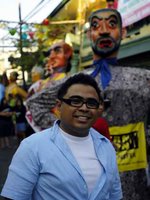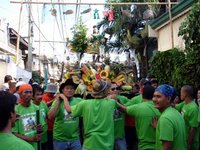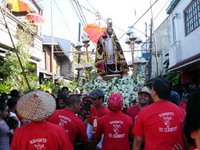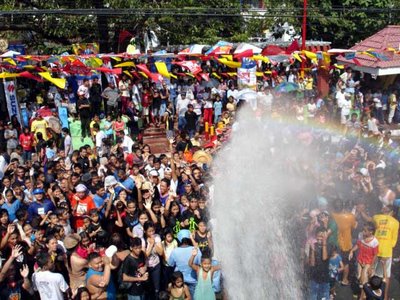 Today, I finally got to visit the town of Angono, Rizal which is known as the Art Capital of the Philippines and the hometown of two national artists namely Carlos "Botong" V. Francisco for painting and Lucio D. San Pedro for music. Our purpose was to check out the annual Higantes Festival as well as the fluvial procession in honor of the town patron San Clemente held every November 23.
Today, I finally got to visit the town of Angono, Rizal which is known as the Art Capital of the Philippines and the hometown of two national artists namely Carlos "Botong" V. Francisco for painting and Lucio D. San Pedro for music. Our purpose was to check out the annual Higantes Festival as well as the fluvial procession in honor of the town patron San Clemente held every November 23.But what a way to start my day! Since on the way to Angono, I got to witness Philippine road courtesy at its worst! Despite the fact that it was still early in the morning, traffic was slow no thanks to the jeepneys who had virtually occupied all three lanes of the road to pick up passengers. Ironically, the shoulders and parking slots on the side of Sta. Lucia East for example was empty and available for use. If we phase out jeepneys from the streets and replace them with an efficient transport system, I could bet you we wouldn't have traffic since most of the grind is a result of undisciplined jeepney drivers and that is virtually all of them!
 You had tricycles on the left as well as center lanes when these slow creatures should use the right lanes. In fact, the law does not allow them on national roads! They are being tolerated and yet they cruise along the busy metropolis streets as if there are no vehicles impatiently following behind them. You had vehicles creating their own counter-flows. Indeed, what a way to start my day!
You had tricycles on the left as well as center lanes when these slow creatures should use the right lanes. In fact, the law does not allow them on national roads! They are being tolerated and yet they cruise along the busy metropolis streets as if there are no vehicles impatiently following behind them. You had vehicles creating their own counter-flows. Indeed, what a way to start my day!But my excitement overtook my impatience and lack of sleep especially as we neared Angono. The access road to the town was blocked so we had to enter it through a side street. We were able to park in front of the town plaza. From there, it was a 1 kilometer walk to the church where the parade and procession was going to originate from. We arrived at the church just in time for the ending of the Mass and the beginning of the festivities in honor of San Clemente.
 It was one big party on the streets of Angono as the loud and rambunctious mardi gras-like parade made its way around town. Of course, there were the higantes, which are colorful paper mache giants measuring about ten to twelve feet in height.
It was one big party on the streets of Angono as the loud and rambunctious mardi gras-like parade made its way around town. Of course, there were the higantes, which are colorful paper mache giants measuring about ten to twelve feet in height.I heard that higantes used to be found in fiesta celebrations around the country. One story of its origin traces back the roots of this practice to the Spanish colonial period. Hacienda owners were wary of expenses and thus prohibited all celebrations except for one annual fiesta. To make the best of a gloomy situation, the townsfolk borrowed an art form imported from Mexico by Spanish friars and created larger-than-life caricatures of their Spanish landlords, a sly joke to get back at them.
 As Angono-based painter Nemiranda recounts, there used to be only two or three higantes at the start of the procession. But because of the large number of artists, which at that time included Botong Francisco, Angono was not only able to maintain this practice. The town elevated it to an art form thanks to creativity of the many artists of the town who made their own versions of the higantes.
As Angono-based painter Nemiranda recounts, there used to be only two or three higantes at the start of the procession. But because of the large number of artists, which at that time included Botong Francisco, Angono was not only able to maintain this practice. The town elevated it to an art form thanks to creativity of the many artists of the town who made their own versions of the higantes. But I would learn that the higantes are just one aspect of this merrymaking. Following them was the procession proper. But this was quite an unusual procession led by altar boys in shorts and rowdy revelers following close behind. Expect to get wet since water is flying all over the place as participants chant "Tubig! Tubig!" asking the people around to throw water at them. Just pray that you don't get hit by a water gun of some wise guy who gets his supply of water from the canal along the street.
But I would learn that the higantes are just one aspect of this merrymaking. Following them was the procession proper. But this was quite an unusual procession led by altar boys in shorts and rowdy revelers following close behind. Expect to get wet since water is flying all over the place as participants chant "Tubig! Tubig!" asking the people around to throw water at them. Just pray that you don't get hit by a water gun of some wise guy who gets his supply of water from the canal along the street.The bulk of the procession was composed of parehadoras, groups of young girls from every barangay, in colorful costumes, wearing wooden slippers (bakya), and each holding a wooden boat paddle (sagwan), marching together and stomping the ground in a uniform beat as they walked around town followed by a marching band.
 And there were various groups of townsfolk in themed spoofs of pop culture icons. I wonder how Kris Aquino would react if she saw who spoofed her and the 26K. Haha! Towards the end of the procession were the andas bearing three images. The first was that of San Isidro Labrador. A little further back was that of the town patron San Clemente escorted by the Knights of St. Clement in red t-shirts. And at the end of the procession was the image of the Virgin Mary escorted by a bevy of young girls in white dresses. Bamboo pole-bars with hanging ornaments were installed along the route. These were raised by levers on either side as an image passed under it.
And there were various groups of townsfolk in themed spoofs of pop culture icons. I wonder how Kris Aquino would react if she saw who spoofed her and the 26K. Haha! Towards the end of the procession were the andas bearing three images. The first was that of San Isidro Labrador. A little further back was that of the town patron San Clemente escorted by the Knights of St. Clement in red t-shirts. And at the end of the procession was the image of the Virgin Mary escorted by a bevy of young girls in white dresses. Bamboo pole-bars with hanging ornaments were installed along the route. These were raised by levers on either side as an image passed under it. We met up again with the parade at the town plaza where it slowed down as louder chants of "Tubig! Tubig!" could be heard, with the crowd summoning the operators of a water truck from Manila Water to hose them down and drench them wet! Everyone wanted his or her share of the water as if it were manna from Heaven.
We met up again with the parade at the town plaza where it slowed down as louder chants of "Tubig! Tubig!" could be heard, with the crowd summoning the operators of a water truck from Manila Water to hose them down and drench them wet! Everyone wanted his or her share of the water as if it were manna from Heaven. But the activities did not end there. The images still had to be brought to the banks of the Laguna de Bay where they would be enshrined in a floating pagoda for a fluvial procession. We decided to take a tricycle going there since it was still a distance away. The pagoda was a simple tent constructed from bamboo. As the last image was brought on board, the pagoda set sail.
But the activities did not end there. The images still had to be brought to the banks of the Laguna de Bay where they would be enshrined in a floating pagoda for a fluvial procession. We decided to take a tricycle going there since it was still a distance away. The pagoda was a simple tent constructed from bamboo. As the last image was brought on board, the pagoda set sail.We didn't finish the entire procession since we wanted to visit the Angono Petroglyphs. On the way back to the plaza, we saw the Blanco Family Museum but since we were on a tricycle, we couldn't stop.
 We got my car and tried to ask around for the petroglyphs. Everyone we asked from the tricycle drivers, the traffic enforcers to the car wash attendants (my car was full of mud so I had it cleaned) had this puzzled look on their faces when we asked about the petroglyphs. Ordinary people in Angono do not know that they have a national cultural treasure in their town. And there were no signages along the main roads pointing to it either!
We got my car and tried to ask around for the petroglyphs. Everyone we asked from the tricycle drivers, the traffic enforcers to the car wash attendants (my car was full of mud so I had it cleaned) had this puzzled look on their faces when we asked about the petroglyphs. Ordinary people in Angono do not know that they have a national cultural treasure in their town. And there were no signages along the main roads pointing to it either!Part 2: Angono is the Art Capital of the Philippines
Part 3: Angono Petroglyphs in Binangonan, Rizal

Oh, it was indeed you !!!!
ReplyDeleteI saw you in one of the Angono streets and wanted to accost you but then at the last moment I said to myself I was wrong (I didn't expected to see you there.)On the other hand I should have followed my gut feeling.
Sayang!
It was a fun day but a bit stressful because of my camera. I ended soaked in water and got smeared with watercolor.
And because I wanted to protect my camera I missed some good shots.
Yup, I had a feeling I saw you too. I think I knew which street that was. It was the one near the church. Also saw you on one of the patrol boats shooting the fluvial procession right?
ReplyDeleteYes, right! I should have recognized you immediately with all the pictures in your blog...
ReplyDeleteAnd you didn't knew how I looked,
so it is entirely my fault!
Next fiesta I will not miss you ! :-)
Wow! this is a great site, lots of features on so many Philippine destinations. Nakakamiss tuloy...but your photos take me there. Thanks.
ReplyDelete...just wanted to say: great pictures and nice travel report! All the best on your adventures.
ReplyDeleteCheers,
Chris
http://www.nomad4ever.com
Oo nga, nabasa kami mismo habang nakasakay ng tricycle! Kainis! Hahaha!
ReplyDeleteHi Ivan!
ReplyDeleteWow, i'm impressed! I study here in Sweden and happen to surf att your site looking for rockcarvings Philippines.
I checked your Resume and wow, again you have a lot of experience.
I leave in Enköping Sweden this link will show you how Enköping care for their rock art. we call it in swedish, "hällristning" http://www.enkoping.se/swwwing/app/cm/Browse.jsp?PAGE=7156
Since you travel a lot, why don't you visit this place? The rockcrvings here are also dating back to 3000BC.
Are those rockcarvings found only in Luzon? what about Visayas and Mindanao?
Thanks,
Greetings from Enköping sweden
Ann May Tubac Badon
my humanities teacher brought us there to show us that the concept of mother and child in art has started since our ninunos' time. hey i always have fun reading your blog!
ReplyDeleteyou should have asked where is the Angono Cave rather than Petroglyps...
ReplyDeleteAngono town fiesta is really one of the best!
ReplyDeletewhen I have enough money... and I have fulfilled my education... I want to transfer there in angono... such a wonderful place... :)
ReplyDelete